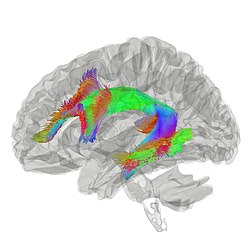弓状束
| 弓状束 | |
|---|---|
 弓状束连接语言中枢的两大区域 | |
 弓状束的纤维跟踪成像 | |
| 韌帶起點 | 额叶布罗卡区 |
| 韌帶終點 | 颞叶韦尼克区 |
| 标识字符 | |
| 拉丁文 | fasciculus arcuatus |
| TA98 | A14.1.09.557 |
| TA2 | 5599 |
| FMA | FMA:260714 |
| 《神经解剖学术语》 [在维基数据上编辑] | |
弓状束(英文:Arcuate fasciculus),是连接大脑语言中枢“布罗卡区”和“韦尼克区”的神经通路,在结构上是连接颞叶皮层尾部和额叶皮层下部的众多神经纤维[1][2]。
结构[编辑]
在结构上,弓状束属于大脑白质的神经径,与上纵束平行分布。由于二者邻近,有些研究人员也将弓状束、上纵束混称[3]。
历史上,弓状束被认为连接语言中枢“布罗卡区”和“韦尼克区”:布罗卡区位于额下回,韦尼克区位于后颞上回。但如今大多数科学家认为这是个过度简化的模型[4]。
功能[编辑]
一些研究人员认为“句法”是人类语言的特质。尽管对于弓状束的具体功能仍有争论,主流理论认为它参与处理复杂的句法[2][5]。有研究显示,随着弓状束的成熟、髓鞘化,人对于句法的处理能力随之提升。此外,弓状束损伤会导致人产生句法处理障碍。
弓状束属于双侧型结构,意味着在两侧的大脑半球中均存在。但是两侧的弓状束不对称:左侧的一般要强于右侧。其中左侧的弓状束被认为参与了句法处理,而右侧的则被认为参与了韵律处理[6][7]。进一步研究显示右侧的弓状束可能与解读人脸表情中的情绪有关[8]。
临床[编辑]
弓状束受损可导致传导性失语症[9]。此外,口吃、特定型语言障碍、失读症也可能与弓状束异常有关[10][11]。
参见[编辑]
参考资料[编辑]
- ^ Noggle, Chad A. Arcuate Fasciculus. Goldstein, Sam (编). Encyclopedia of Child Behavior and Development. Boston, MA: Springer US. 2011: 141–141. ISBN 978-0-387-79061-9. doi:10.1007/978-0-387-79061-9_179 (英语).
- ^ 2.0 2.1 Arcuate Fasciculus - an overview. Science Direct. [2021-03-27]. (原始内容存档于2022-01-08) (英语).
- ^ Jeremy D. Schmahmann; Deepak N. Pandya. Fiber Pathways of the Brain. 2006 [2021-03-27]. (原始内容存档于2022-01-19) (英语).
- ^ Dick, Anthony Steven; Tremblay, Pascale. Beyond the arcuate fasciculus: consensus and controversy in the connectional anatomy of language. Brain. 2012-12-01, 135 (12): 3529–3550. ISSN 0006-8950. doi:10.1093/brain/aws222.
- ^ Wilson, Stephen M.; Galantucci, Sebastiano; Tartaglia, Maria Carmela; Rising, Kindle; Patterson, Dianne K; Henry, Maya L.; Ogar, Jennifer M.; DeLeon, Jessica; Miller, Bruce L. Syntactic processing depends on dorsal language tracts. Neuron. 2011-10-20, 72 (2): 397–403 [2021-03-27]. ISSN 0896-6273. PMC 3201770
 . PMID 22017996. doi:10.1016/j.neuron.2011.09.014. (原始内容存档于2021-09-18).
. PMID 22017996. doi:10.1016/j.neuron.2011.09.014. (原始内容存档于2021-09-18).
- ^ Friederici, Angela. Language in our brain : the origins of a uniquely human capacity. Cambridge, Massachusetts: The MIT Press. 2017. ISBN 9780262036924.
- ^ Vandermosten, Maaike; Boets, Bart; Wouters, Jan; Ghesquière, Pol. A qualitative and quantitative review of diffusion tensor imaging studies in reading and dyslexia. Neuroscience & Biobehavioral Reviews. 1 July 2012, 36 (6): 1532–1552 [2021-03-27]. ISSN 0149-7634. doi:10.1016/j.neubiorev.2012.04.002. (原始内容存档于2019-10-20).
- ^ Nakajima, Riho; Yordanova, Yordanka N.; Duffau, Hugues; Herbet, Guillaume. Neuropsychological evidence for the crucial role of the right arcuate fasciculus in the face-based mentalizing network: A disconnection analysis. Neuropsychologia. July 2018, 115: 179–187. doi:10.1016/j.neuropsychologia.2018.01.024.
- ^ Bernal, Byron; Ardila, Alfredo. The role of the arcuate fasciculus in conduction aphasia. Brain: A Journal of Neurology. 2009-09, 132 (Pt 9): 2309–2316 [2021-03-27]. ISSN 1460-2156. PMID 19690094. doi:10.1093/brain/awp206. (原始内容存档于2021-04-25).
- ^ Cieslak, M; Ingham, R; Ingham, J; Grafton, S. Anomalous white matter morphology in adults who stutter. Journal of Speech, Language, and Hearing Research. 2015, 58 (2): 268–277. PMC 4675119
 . PMID 25635376. doi:10.1044/2015_JSLHR-S-14-0193.
. PMID 25635376. doi:10.1044/2015_JSLHR-S-14-0193.
- ^ Vandermosten, Maaike; Boets, Bart; Wouters, Jan; Ghesquière, Pol. A qualitative and quantitative review of diffusion tensor imaging studies in reading and dyslexia. Neuroscience & Biobehavioral Reviews. 1 July 2012, 36 (6): 1532–1552 [2021-03-27]. ISSN 0149-7634. doi:10.1016/j.neubiorev.2012.04.002. (原始内容存档于2019-10-20).
